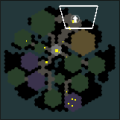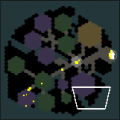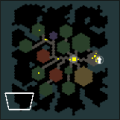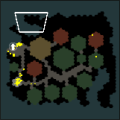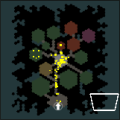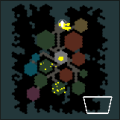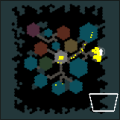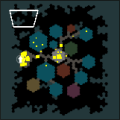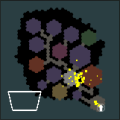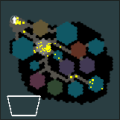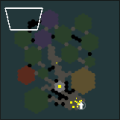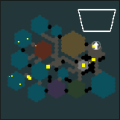Colony: Difference between revisions
mNo edit summary |
mNo edit summary |
||
| Line 125: | Line 125: | ||
Nest design and unit compostition is affected by species choices and temperament settings. They can decide building order on their own. They can only build hexagon chambers and can't build highway. | Nest design and unit compostition is affected by species choices and temperament settings. They can decide building order on their own. They can only build hexagon chambers and can't build highway. | ||
*Docile colonies have | *Docile colonies have a lot of workers. | ||
*Timid colonies have balanced | *Timid colonies have balanced number of workers, small soldiers and large soldiers. | ||
*Balanced and aggressive colonies have | *Balanced and aggressive colonies have balanced number of small soldiers and large soldiers. | ||
'''Black ants/ Fire ants/ Little black ants/ Matabele ants''' | '''Black ants/ Fire ants/ Little black ants/ Matabele ants''' | ||
Revision as of 12:13, 22 September 2024
This page shows the mechanics of colonies.
Mechanics
You can play with 9 different colonies in the entire game. If you choose to play with wood ants, leafcutter ants, fire ants or Matabele ants, you must pick either of the 2 variants.
You can only control a single colony in any levels or custom games. Non-player colonies can use the same mechanics as you can but are controlled by the game. Every colony must be assigned to a number, a color and an underground area.
Non-player colonies and swarm enemies are always hostile to eachother.
The respective colony is defeated when its queen is dead. Tiles are deleted every 0.5 seconds and return 66% of the building cost. Refunds are modified to reward the victors: larvae, leaves, termites or lignocellulose.
Levels
Behaviors
Non-player colonies in story levels and extra levels are designed to mimic their real-life counterparts. Nanitic workers are always kept inside to do nest jobs.
Non-player colonies check the surface for food and move gathering groups there.
- None: Non-player colonies simply follow instructions and can't respond to anything.
- Old system: Non-player colonies can only check predetermined locations. Gathering groups move to the most recently chosen locations if they can't find any food.
- New system: Non-player colonies can constantly and thoroughly scan their territories for food or danger and move pheromone groups accordingly. Gathering groups remain inside if they can't find any food.
Non-player colonies can only control up to 3 pheromone groups.
- Species with same-sized soldiers: Gathering groups consist of workers and soldiers. Attacking groups only consist of soldiers and usually join them to gather food on the surface.
- Species with different-sized soldiers: Gathering groups consist of workers and/or small soldiers. Attacking groups only consist of large soldiers and are usually kept the around the queen.
Gathering groups attack any enemies on the way when they are tasked with gathering food. Food gathering and attacking is disabled when they are tasked with taking aphids.
Gathering groups will retreat inside after they have taken enough casualties. Attacking is disabled in the process.
Attacking groups are only deployed to invade your nest or to protect gathering groups. Gathering is disabled in the process and is only enabled during retreat.
Non-player colonies can only choose between attacking and retreating in tug-of-war levels. Gathering is always enabled.
Actual players are more decisive and responsive so non-player colonies always need headstart and cheat to stay threatening. Only free-food cheat is available in story levels and extra levels.
Nest building
Non-player colonies have predetermined nest designs. They can decide building order on their own. They can only build hexagon chambers and can't build highways.
Appearances
You can encounter non-player colonies in:
- Queen of the Hill (none)
- The Harvest (old)
- Possibly the Final Experiment (tug-of-war)
- Cold Blood (new)
- A Bridge Too Far (new)
- Triage (new)
- Drive Them Back (new)
- Last Mound Standing (new)
- Babysitting (none)
- The Other Foot (tug-of-war)
- Tug of War (tug-of-war)
- Hibernation (old)
- Adventure (old)
- Tug of War 2 (tug-of-war)
- Tug of War 3 (tug-of-war)
Custom games
Settings
You can play with or without other colonies in custom games. You must choose a color and a team for each colony before you start a custom game. You can only have up to 4 colonies and 4 teams in a single custom game.
Some colonies may have different start from story levels and extra levels.
- Leafcutter ant colonies have nineteen-tiled queen chambers.
- Matabele ant colonies must start with some soldier brood tiles.
- Termite colonies have nineteen-tiled queen chambers and must start with some lignocellulose storage tiles and/or some fungus storage tiles.
You can control temperament of non-player colonies: Docile, Timid, Balanced and Aggressive. It affects their aggressiveness and unit composition.
You can also control how quickly non-player colonies make decision.
You can also control their headstart and cheat frequency: None, Headstart, Underhanded, Cheater, Crooked and Corrupt. Non-player colonies can gain free food over time, receive less damage from surface enemies or spawn units without requiring food or workers. Cheat is disabled when nest invasion is happening.
Non-player colonies aren't affected by upkeep and randomized caverns. You can control whether colonies can enter other nests.
Behaviors
Non-player colonies will send all units outside to gather food. Nanitic workers will stay inside after you have played for 10 minutes and are only deployed when non-player colonies don't have any other units.
Non-player colonies can only control up to 3 pheromone groups. They can be assigned with gathering food, taking aphids or attacking enemy colonies.
Gathering groups attack any enemies on the way when they are gathering food. Food gathering and attacking is disabled when they are taking aphids.
Gathering groups are kept inside if they can't find any food.
Non-player colonies will choose the weakest colonies in biomass as their targets after they have enough food. Attacking groups either follow their most recently placed pheromone markers or invade their nests. Food and aphid gathering is disabled in the process.
Attacking groups will be tasked with gathering food and retreat after they have taken enough casualties.
Attack frequency is affected by temperament settings.
Non-player colonies will retreat inside when nest invasion occurs or when water level is about to change.
Non-player colonies can actively hunt uber creatures when the victory condition requires.
Nest building
Non-player colonies always start with the same predug nest and some resources. They usually work on 2 chambers at once. They prioritize upgrading storage and soldiers first. They only upgrade workers after other building jobs have been finished.
Nest design and unit compostition is affected by species choices and temperament settings. They can decide building order on their own. They can only build hexagon chambers and can't build highway.
- Docile colonies have a lot of workers.
- Timid colonies have balanced number of workers, small soldiers and large soldiers.
- Balanced and aggressive colonies have balanced number of small soldiers and large soldiers.
Black ants/ Fire ants/ Little black ants/ Matabele ants
Wood ants
Big-headed ants
Leafcutter ants
Termites
Gene-thief ants
Gene-thief ant units are divided into 3 groups: workers, small soldiers and large soldiers. Large soldiers include leafcutter ant majors, army ant majors and bigheaded ant supersoldiers. Small soldiers include other units. Unit composition is affected by available unit groups. Non-player colonies can't use [[Bullet Ant|bullet ant soldiers].
If they have access to multiple options in the same group, they will choose randomly among the available options and build a chamber for each option.
If large soldiers aren't available, they are replaced with small soldiers. If small soldiers aren't available, they are replaced with workers.
Trivia
- Non-player gene-thief ant colonies can't use Matabele ant soldiers, termite minor soldiers and termite major soldiers in freeplay in the current version.
 Hooded Horse Wikis
Hooded Horse Wikis